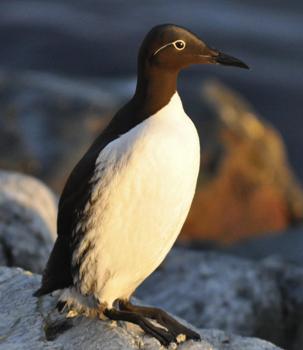May 30 2015
Collaboration between ecologists and climate researchers in Norway has generated fascinating new insight into how seabirds are affected by climate change.
 The common guillemot. Photo: Tone Kristin Reiertsen
The common guillemot. Photo: Tone Kristin Reiertsen
Until recently, ecologists used a specific set of methods to study the relationship between animals and climate change, one of which is the NAO index (North Atlantic Oscillation), which measures differences in air pressure between Portugal and Iceland.
If no correlation was found here, some ecologists refuted that climate change is causing the observed changes.
Dark figures
"This is a gross oversimplification. You could even say that until now we have not been able to see the trees for the forest. Now we are trying to see each individual tree as well. Many changes caused by climate change will never be detected using only the NAO Index. We are revolutionising the research on the connection between animals and climate change," says researcher Michel d. S. Mesquita at Uni Research Climate and the Bjerknes Centre.
Mesquita has started collaborating with ecologists at the High North Research Centre for Climate and the Environment (the Fram Centre), the Norwegian Institute for Nature Research (NINA), the Norwegian University of Science and Technology (NTNU) and climatologists at the University of Reading in the UK and the Max Planck Institute for Meteorology in Hamburg. Together they have used traditional methods from climate research to study how animals are affected by changes in the climate. This has not been done before.
Virtually extinct
Researchers have studied the distribution of the common guillemot, a seabird similar to penguins. The common guillemot is an endangered species in Norway and is on the Norwegian Red List. In the 1960s there were around 160,000 pairs in Norway; today there are only 15,000 breeding pairs left.
Senior Researcher Kjell Einar Erikstad has studied the common guillemot population closely. There are therefore good coherent data on this population. In winter 1986–87 something strange happened to the common guillemot population. An unusually large number of birds were found starving and dead in the sea. Researchers looked into this incident to try to determine if it could be linked to climate change.
"We found out that that winter there was an unusually high number of high pressure systems over the Barents Sea combined with polar lows. We found this out using traditional methods from climate research, such as point maps," says Mesquita.
Point maps are maps where the same climatic data are measured at a number of different geographical points for comparison with changes in animal populations. This is the method used by Jacob Bjerknes in 1969 to explain El Niño. El Niño is a global phenomenon that arises in the ocean and in the atmosphere, leading to large temperature fluctuations in the surface water of the Pacific Ocean.
Less upwelling
One of the consequences of the high pressure was that there was less upwelling of the water in the ocean. This meant that food and nutrients remained on the seabed and were therefore not available for fish. Fish stocks declined, which in turn affected the seabirds.
The extreme high pressure over the Barents Sea also led to a decrease in the air temperature. Guillemots are sensitive to temperature and cannot survive if it is too cold for any length of time.
"The findings we have made here may be relevant to climate change in the future, resulting in more or fewer birds. This is part of the research we are working on going forwards. We observe that climate change can lead to a decline in animal populations," says Mesquita.
The common guillemot spends the whole winter out in the Barents Sea and is therefore particularly vulnerable to the conditions there during the winter months. The birds dive to find food, and can dive down to depths of up to 150 metres. Using dive logs that record the pressure the birds are exposed to, we now know that the birds dive down to 150 metres in the winter and some 7–8 metres in the summer. The common guillemot only goes ashore to nest.
"Using these traditional methods and not only the NAO Index gives us a better understanding of what is happening to the seabirds. We can also use these methods to find out how other species are affected by climate change," says Mesquita.
Looking ahead
"A challenge for the coming years is to use these kinds of climate models to be able to make predictions about populations and ecosystems in the future. This collaboration has already given us several new projects at the Fram Centre in Tromsø, and we are currently preparing projects for the Research Council of Norway," says Kjell Einar Erikstad, Senior Researcher at NINA.